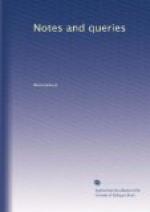1. Whether there be any historical authority for Waltheof being sent as envoy to William? and, if so, on what mission?
2. Is it not the more correct account, that the Conqueror gave his niece Judith in marriage to Waltheof after the surrender of the city, [at the same time that he conferred other honours upon him, out of respect for his brave defence of the city; creating him, first, Earl of Northhampton and Huntingdon, and afterwards Earl of Northumberland, A.D. 1070.] And if so, as Waltheof could certainly not have had any “pledge of love” before the siege of York; so neither is it probable that he had any issue at all by Judith, as in the same year, 1070, he was beheaded by William, for supposed participation in a conspiracy at York.
The above drama is said to be “by a descendant of one of the dramatis personae,” viz. of “De Combre, one of William’s generals;” being written by Rev. Thomas Comber, of Oswaldkirk, Yorkshire. This De Combre is represented as having married Ilda, a daughter of King Harold, and sister of Edgar. Can any of your correspondents furnish me with information as to the origin and antiquity of this family of Comber? I learn from the present representatives of this family, that they have no recorded pedigree which goes higher than the reign of Henry VI., but that the family tradition has always been, that their ancestor came over from Normandy with William, and married Ilda, daughter of Harold. It seems that the name of Ilda is at this very day borne by one of the family. In the Memoirs of Dr. Thomas Comber, Dean of Durham, this De Combre is said to have had the manor of Barkham, in Sussex, given to him by the Conqueror. What family had King Harold II.? Had he any daughter Ilda? and, if so, is there any record or mention of her husband’s name?
T.E.L.L.
19th July, 1850.
"De male quaesitis,” &c.—Spelman’s striking argument, that spoliated church property is seldom enjoyed for more than three generations, seems but a special application of a general principle,—
“De male quaesitis gaudet non tertius haeraes.”
Can any of your readers tell me who is the author of the above verse? I find it quoted as “an adage” by John Gadsbury, in his work On the Doctrine of Nativities, 1658.
R.P.
Westminster Abbey.—The late Sir Harry Englefield is known to have had access to some of the original fabric accounts of this venerable structure. Can any of your readers inform me whether he published the information he may have obtained from those documents; and, if so, where it may be found?
J.BT.




